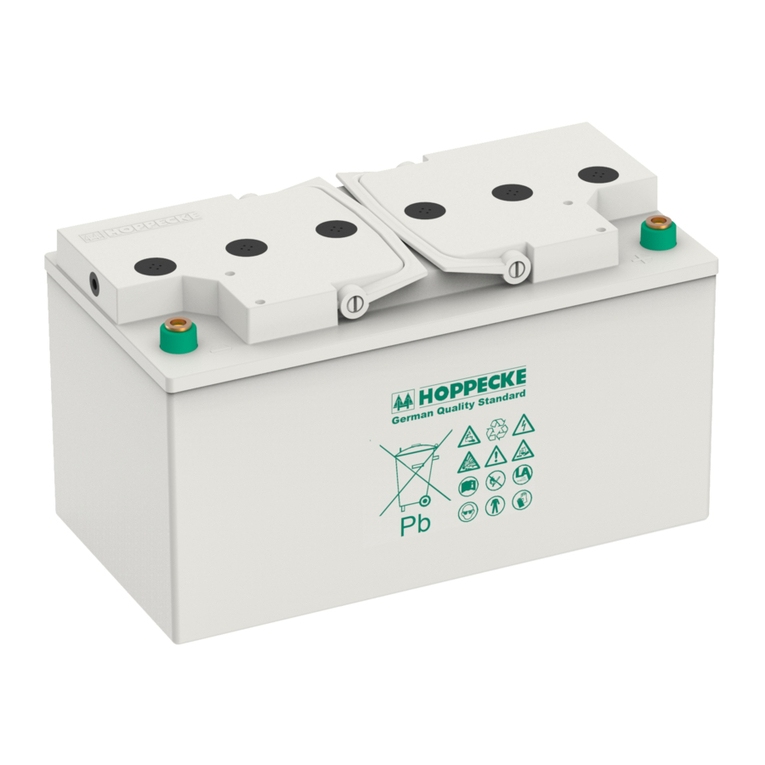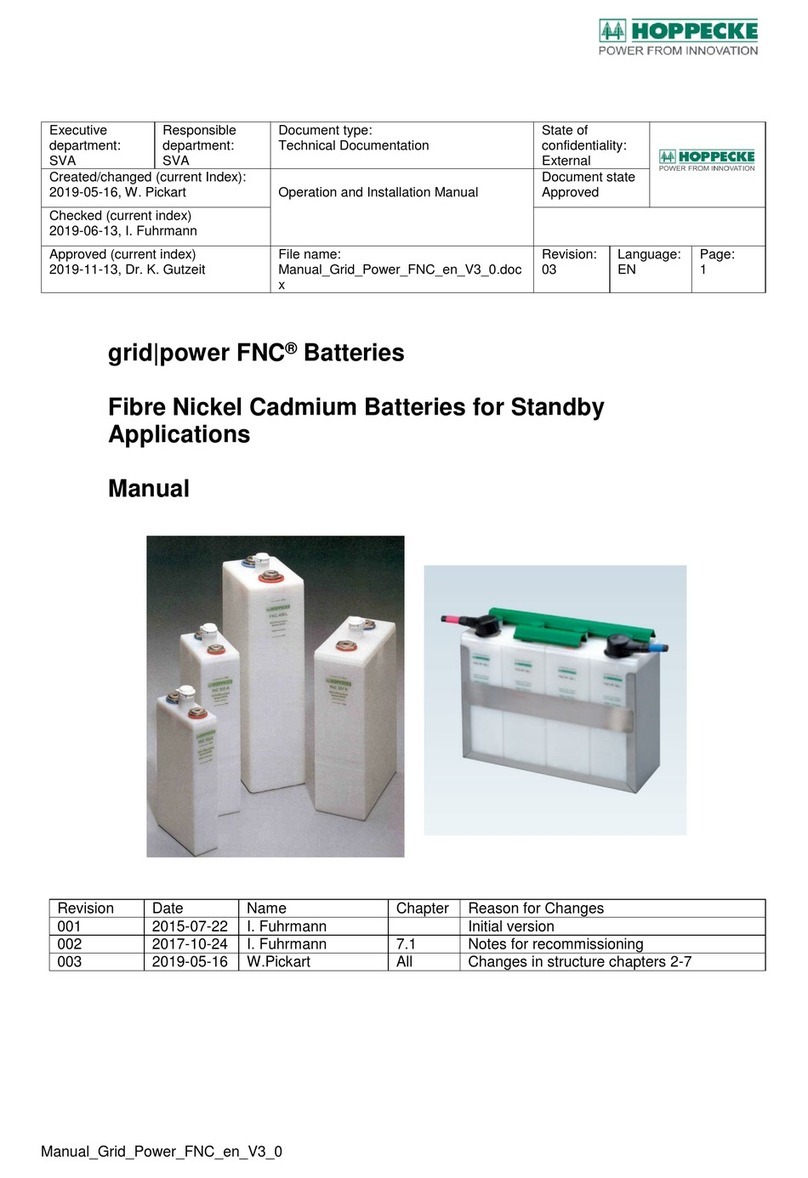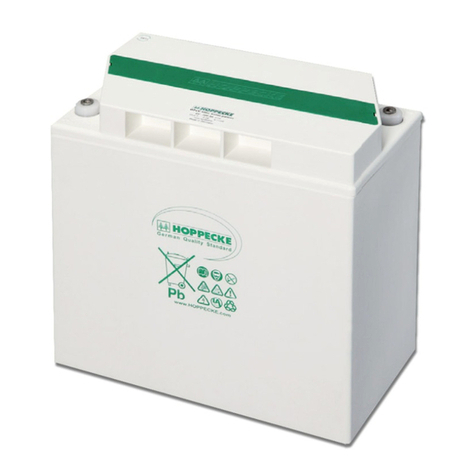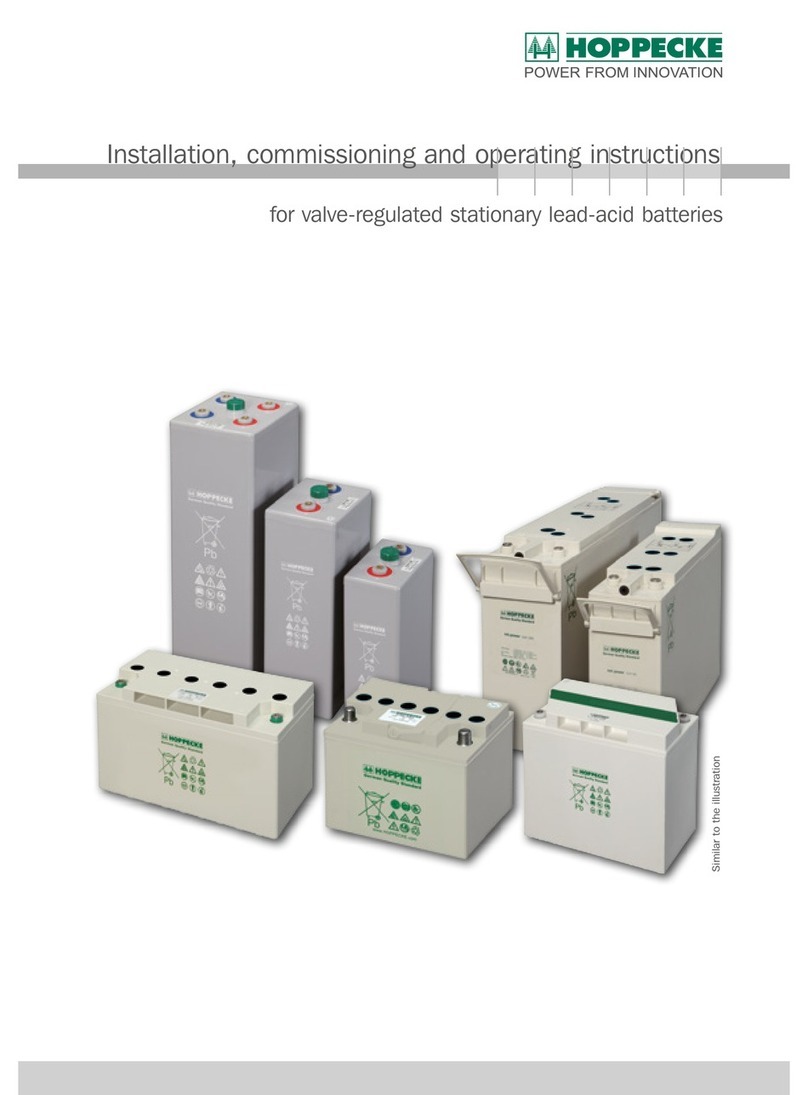
trak®bloc batteries have low gas
emissions but are not completely free
from gas emissions.
It must be ensured that the charging gases
are drained off effectively during charging.
Covers on battery installation spaces must
be opened or removed.
The battery must be connected to the
charger with the correct polarity (positive to
positive and negative to negative) when the
charger is switched off. The charger must
then be switched on.
During charging, the temperature in the
battery increases by approx. 10 K.
Therefore, charging should only be started
when the temperature is below 35 °C. The
temperature prior to charging must be at
least 15 °C, as otherwise the battery will not
reach a sufficient level of charge during the
prescribed charge time.
If temperatures are consistently higher than
40 °C or lower than 15 °C, the charger will
need to undergo constant voltage regulation
dependent upon the temperature.
A correction factor of -0.003 V/Z per K
should be applied here.
2.3 Equalising charge
Equalisation charging is used to guarantee
the service life and to preserve the capacity.
Equalisation charging must be carried out
following normal charging.
This type of charging must be carried out
following deep discharge and repeated
insufficient charging. Only those chargers
that have been approved by the battery
manufacturer may be used for equalisati-
on charging. It is also recommended that
equalisation charging be carried out with
constant current once every quarter. The
charging current can be a maximum of 0.8 A
per 100 Ah C5rated capacity, and must be
deactivated after a maximum of 5 hours.
The charge voltage must not exceed 2,6 V
per cell. Observe the limit temperature!
Charging must be interrupted if the limit
temperature is exceeded.
2.4 Temperature
30 °C battery temperature is considered
the rated temperature. Higher temperatures
reduce the service life, while lower tempera-
tures reduce the available capacity.
45 °C is the upper limit temperature and
is not permissible as an operating tempe-
rature.
Therefore, trak®bloc batteries must not be
exposed to sunlight without protection.
2.5 Electrolyte
The electrolyte takes the form of suspended
sulphuric acid. The density of the electroly-
tes cannot be measured.
3. Maintenance
Do not top up with water!
Never open or remove the valves.
3.1 Daily
Charge the battery immediately after every
discharge.
3.2 Weekly
Carry out a visual inspection for contamina-
tion and mechanical damage.
3.3 Quarterly
The following must be measured and recor-
ded once the battery has been fully charged,
after a waiting time of at least 12 hours:
- Total voltage
- Individual voltage of the block batteries
If significant changes to previous measure-
ments or differences between the block bat-
teries are identified, then Customer Service
must be contacted for further testing or
repairs.
3.4 Yearly
(only for batteries in a steel trough)
In accordance with EN 62485-3, the insu-
lation resistance of the vehicle and the
battery must be checked by a specialised
electrician.
The battery insulation resistance check must
be performed in accordance with EN 1987-1.
The established battery insulation resistance
must not be below 50 Ohm per Volt of rated
voltage.
For batteries with a rated voltage of 20 V,
the minimum value would be 1000 Ohm.
4. Care
The battery must always be kept clean and
dry in order to prevent leakage currents.
Cleaning must be performed in accordance
with the ZVEI data sheet „Cleaning batteries“.
5. Storage
If batteries are taken out of operation for
extended periods, then they must be stored
fully charged in a dry and frost-free location.
In order to ensure that these batteries stay
ready for operation, the following charging
procedures must be applied:
Quarterly full charging as per Item 2.2.
If consumers such as measuring or control
equipment are connected, it may be neces-
sary to carry out a full charge every 14 days.
In general, self-discharge of 2 % per month
is to be expected.
The storage time should be taken into
account in any service life estimates.
6. Faults
If any faults are detected on the battery or
charger, contact Customer Service imme-
diately.
HOPPECKE Service:
+49 (0) 2963 61-591
Measured data as per Item 3.3 make trou-
bleshooting and fault rectification easier.
A service contract with HOPPECKE makes
it easier to detect faults in good time, to
prevent faults and to remedy any faults that
may occur.
7. REACH Statement Pb-Metal:
According to REACH regulation we inform
that, PzS- and PzB Batteries are containing
the SVHC substances Lead-metal (CAS.
Nr. 7439-92-1) with more than 0.1 weight %.
MSDS is available upon request from your
account manager.
For further information regarding REACH
please refer to https://echa.europa.eu.
Teil-Nr. 7240203030/04.21
HOPPECKE Batterien GmbH & Co. KG
P.O. Box 1140 · D-59914 Brilon
Bontkirchener Straße 1 · D-59929 Brilon-Hoppecke
Fax: + 49 (0) 29 63 61-735 Internet: www.hoppecke.de
Pb
Used lead-acid batteries constitute waste for recycling that requires special monitoring. These batteries, which feature the
recycling logo and a crossed-out dustbin, must not be disposed of with household waste. The method of return and recycling must
be agreed upon with the manufacturer in accordance with Section 8 of the German Battery Ordinance (BattV).

























